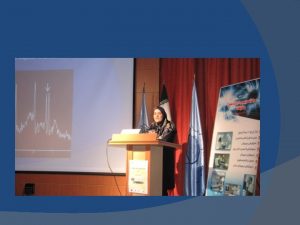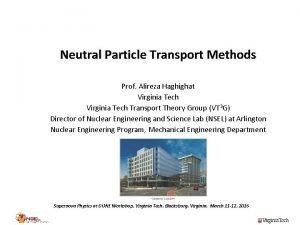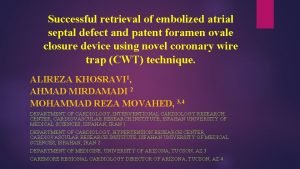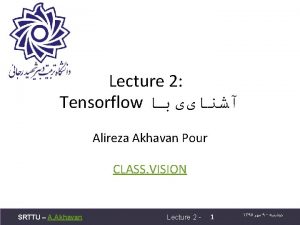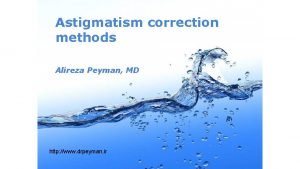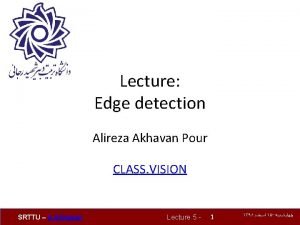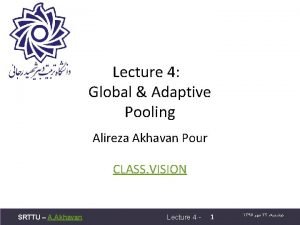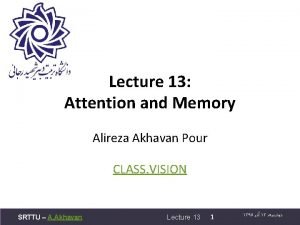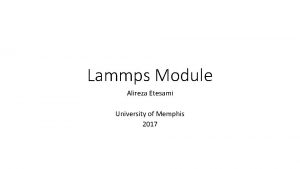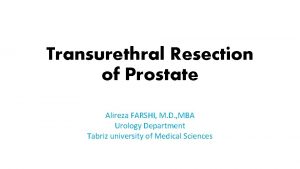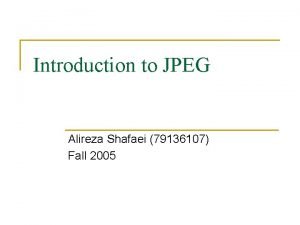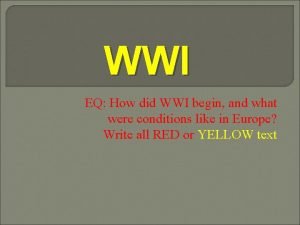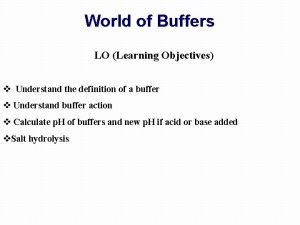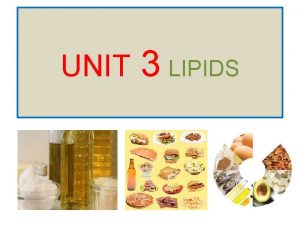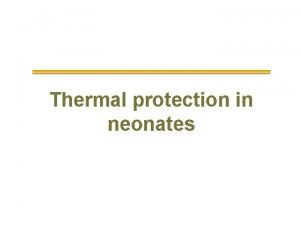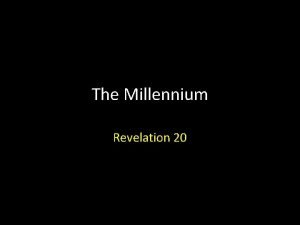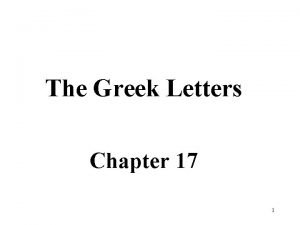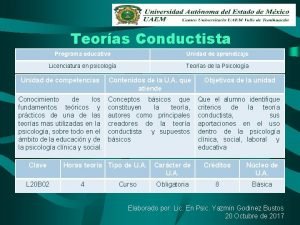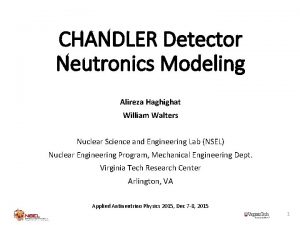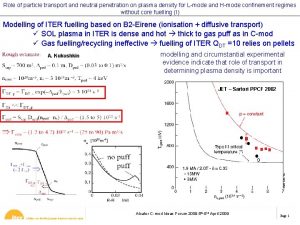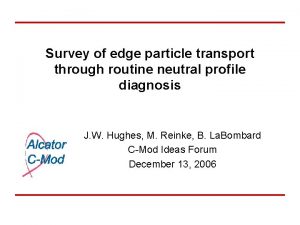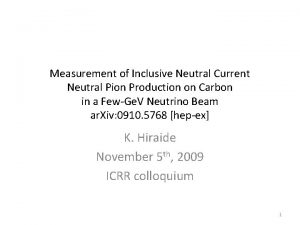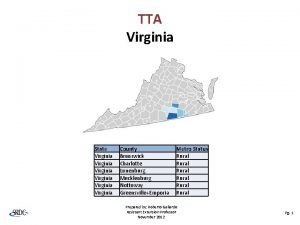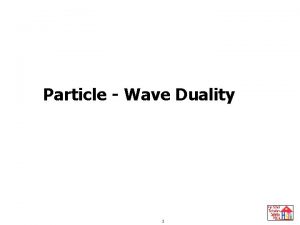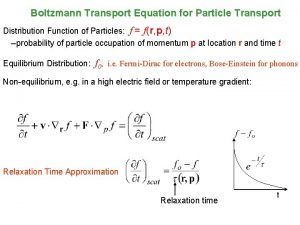Neutral Particle Transport Methods Prof Alireza Haghighat Virginia






































- Slides: 38

Neutral Particle Transport Methods Prof. Alireza Haghighat Virginia Tech Transport Theory Group (VT 3 G) Director of Nuclear Engineering and Science Lab (NSEL) at Arlington Nuclear Engineering Program, Mechanical Engineering Department Supernova Physics at DUNE Workshop, Virginia Tech, Blacksburg, Virginia, March 11 -12, 2016

Particle Transport Theory Objective Determine the expected number of particles in a phase space (d 3 rd. Ed ) at time t: d. E z d 3 r dΩ Ω r y x Number density is used to determine angular flux/current, scalar flux and current density, partial currents, and reaction rates. 2

Simulation Approaches • Deterministic Methods • Solve the linear Boltzmann equation to obtain the expected particle flux/current/reaction rate in a phase space • Statistical Monte Carlo Methods • Perform particle transport experiments using random numbers (RN’s) on a computer to estimate expected number of particles in phase space and associated uncertainty. 3

Deterministic – Linear Boltzmann Equation • Integro-differential form streaming collision scattering fission Independent source • Integral form 4

Integro-differential - Solution Method • Angular variable: Discrete Ordinates (Sn) method: A discrete set of directions { weights {wm} are selected } and associated • Spatial variable Integrated over fine meshes using FD or FE methods • Energy variable Integrate over energy intervals to prepare multigroup cross sections, σg A typical shielding problem Memory : 80 angles x 50 g x 106 x 8 bye/word = 32 GB 5

Integral - Solution method • Characteristic Method (CM): Model is partitioned into coarse meshes and transport equation is solved along the characteristic paths (k) (parallel to each discrete ordinate (n)), filling the mesh, and averaged 6

Monte Carlo Methods • Perform an experiment on a computer; “exact” simulation of a physical process Pathlength Type of collision Scattering angle (isotropic scattering) Sample S (r, E, Ω) Tally (count) absorbed Issue: Precise expected values; i. e. , small relative uncertainty, Requires significant computation time, Variance Reduction techniques are needed for realworld problems! 7

Deterministic vs. Monte Carlo Item Deterministic MC Discrete/ Exact Discrete/ Truncated series Exact Difficult simple Computer memory Large Small Computer time Small Large Convergence Statistical uncertainty Large Limited Complex Trivial Geometry Energy treatment – cross section Direction Input preparation Numerical issues Amount of information Parallel computing 8

Advanced Algorithms/codes for solving the linear Boltzmann Equation PENTRAN (1996) TITAN (2004) 9

PENTRANTM- (Parallel Environment Neutral-particle TRANsport) (G. Sjoden and A. Haghighat, 1996) ANSI FORTRAN 90 with MPI library (Export classification 0 D 999 B available for use in most countries) o Cartesian geometry o o Coarse-mesh-oriented data structure allowing localized meshing, differencing scheme o Parallel processing: Hybrid domain decomposition (angle, energy, and/or space); Parallel I/O; Partition memory o Adaptive Differencing Strategy (ADS): Diamond Zero (DZ) Directional Theta. Weighted differencing (DTW) Exponential-Directional Iterative (EDI) o Fully discontinuous variable meshing - Taylor Projection Mesh Coupling (TPMC) o Angular quadrature set: Level symmetric (up to S 20) and Pn-Tn with OS 9

Discretized x-y-z Sn formulation in PENTRAN (discrete ordinates, finite volume, multigroup) where 11

PENTRAN Code System Pre-processing PENMSH-XP (prepares mesh, source, and material distributions) SN Transport Calculation Post-processing (Parallel Environment Neutral-particle TRANsport) PENPRL (extract flux values and compare with experimental data) 12

Benchmarking and Applications of PENTRAN Benchmarking Kobayashi 3 -D Benchmarks VENUS-3 Benchmark facility C 5 G 7 Criticality benchmark Real-world Problems BWR Core-Shroud Pulsed Gamma Neutron Activation Analysis (PGNAA) device X-Ray room CT Scan Time-of-Flight (TOF) Co source Storage CASK UF Training Reactor 13

TITAN - Hybrid Sn & CM Algorithm (C. Yi, A. Haghighat, 2004) Sn Solver CM solver 14

TITAN Sn-CM Algorithm CM Sn A B E. g. , LD Scheme; 15

TITAN – A 3 -D Parallel Hybrid Transport Code • Written in Fortran 90 (with some features in Fortran 2003 standard, such as dynamic memory allocation and object oriented 23) and MPI library • Compiled by Intel Fortran Compiler (ifc 8. 0+) or PGI f 90 compiler (pgf 90 6. 1) • Coarse-mesh-oriented data structure allowing localized meshing, quadrature and solver. • Coarse-mesh based Hybrid Algorithms • • Sn and Characteristics Sn with fictitious quadrature and ray tracing for image reconstruction for SPECT 16

• Simplified ray-tracing with fictitious-quadrature-set solver for SPECT image reconstruction Ray-tracing with Fictitious Quadrature SN CM TITAN 17

TITAN Benchmarking and Application • OECD/NEA Benchmarks • • C 5 G 7 MOX Kobayashi 3 -D parameter space VENUS-2 • Applications • Adjoint calculation for the AIMS active interrogation simulation tool • m. Power reactor core and external modeling • Modeling of a penetration duct in a nuclear reactor • Benchmarking the multigroup SDM (subgroup decomposition method) algorithm (developed by Georgia Tech) • Medical applications • Modeling a CT machine • Developed an image reconstruction algorithm, TITAN-IR 18

Fission Density in Penn State Reactor 3 -D Meshing of a BWR core and structure Meshing for modeling a Time-of. Flight (TOF) Experiment Neutron flux distribution throughout a spent fuel dry cask 3 -D DPA of a BWR core shroud SPECT Imaging A 3 -D mesh model for the UF Nuclear Reactor XY mesh model for a benchmark with UO 2 and MOX fuel With 10’s and 100’s processors, still requires hours of computation time Power, Nondestructive Detection, Medicine (past work) Modeling nuclear systems-Samples 19

Why not hybrid Monte Carlo – deterministic methods? Variance reduction (VR) with the use of deterministic importance function VT 3 G has developed CADIS variance reduction methodology and automated VR software A 3 MCNP in 1997; CADIS has become popular recently! 20

“Forward” Transport & “Importance” Equations • “Forward” transport equation is expressed by in V where , • “Importance” equation is expressed by in V where 21

An application of Adjoint function - Detector Response • Detector response is obtained by • If derive the commutation relation between the “forward” and “adjoint” transport equations, detector • Then, we obtain the following equality • If we consider • Then, 22

CADIS – Consistent Adjoint Driven Importance Sampling (J. Wagner and A. Haghighat, 1997) Description: Uses an approximate 3 -D SN importance function distribution for • source biasing Detector • transport biasing – splitting & rouletting in a consistent manner, within the weight-window technique. Source 24

CADIS Transport biasing Source biasing • If Particle weight <1, particles are processed • through the Russian roulette, Otherwise, particles are split • Particle statistical weight 25

A 3 MCNP - Automated Adjoint Accelerated MCNP (J. Wagner and A. Haghighat, 1997) Step 1 mesh distribution material composition input files multi-group cross sections SN adjoint function Step 2 VR parameters Step 3 non-analog MC Calculation 26

Applications • PWR Cavity dosimetry • BWR core shroud • Spent fuel Storage cask 27

Simulation of Storage Cask n n n CASK library (22 n, 18 g) 17 Materials 318, 426 fine meshes (1000 coarse meshes) (40 z-levels) P 3, S 12 (168 directions) 1. 48 GB per processor 8 processors (~12 GB Total) 16 -processor, PCCluster (4 GB/proc) 28 28

Segments Near Top (494 cm – 563 cm) No results for unbiased MCNP after 214 hours on 8 processors! Requires months & years! A 3 MCNP on 1 processor after 8 hours achieve a relative error less than 5%

Even advanced fast particle transport methods are slow, because of significant number of unknowns 31

Development of Transport Formulations for Real-Time Applications • Physics-Based transport methodologies are needed: • Developed Multi-stage, Response-function Transport (MRT) methodology • Based on problem physics partition a problem into stages (subproblems), • For each stage employ response method and/or adjoint function methodology • Pre-calculate response-function or adjoint-function using an accurate and fast transport code • Solve a linear system of equations to couple all the stages 32

Examples for MRT Algorithms • Nondestructive testing: Optimization of the Westinghouse’s PGNNA active interrogation system for detection of RCRA (Resource Conversation and Recovery Act) (e. g. , lead, mercury, cadmium) in waste drums (partial implementation of MRT; 1999) • Nuclear Safeguards: Monitoring of spent fuel pools for detection of fuel diversion (2007) (funded by LLNL) (INSPCT-s software) • Nuclear nonproliferation: Active interrogation of cargo containers for simulation of special nuclear materials (SNMs) (2013) (in collaboration with Ga. Tech) (AIMS software) • Spent fuel safety and security: Real-time simulation of spent fuel pools for determination of eigenvalue, subcritical multiplication, and material identification (partly funded by I 2 S project, led by Ga. Tech) (Ongoing) (RAPID software, filed for patent) • Image reconstruction for SPECT (Single Photon Emission Computed Tomography): Real-time simulation of an SPECT device for generation of project images using an MRT methodology and Maximum Likelihood Estimation Maximization (MLEM) (filed for a patent, June 2015) (TITAN-IT software) 33

Atucha-I Spent Fuel Pool Inspection (Development of a tool for safeguards) (funded by LLNL) Objective – Identification of missing/moved assemblies for safeguards Approach – Combination of measurement and on-line computation to obtain trending curves 35

Hybrid Methodology • Source (S = Sintrinsic + Ssubcritical-Multiplication) • Intrinsic Source • Spontaneous fission & (a, n) from fuel burnup calculation (ORIGEN-ARP) (Created a database) � Subcritical Multiplication (Hybrid method) Simplified fission-matrix (FM) method � Use MCNP Monte Carlo to obtain ai, j for each pool type (Created a database for coef. aij) � � Adjoint function � Is obtained using the PENTRAN transport code (Created a database for multigroup adjoint for different lattice sizes)

INSPCT-S program Input databases tolerance

VT 3 G Milestones & Contributing Current/Former Students (1986 -2015) 19861989 • Vector computing of 1 -D Sn spherical geometry algorithm • Development an adjoint methodology for simulation TMI-2 reactor Prof. Haghighat 19891992 • Vector and parallel processing of 2 -D Sn algorithms • Simulation of Reactor Pressure Vessel (RPV) Prof. R. Mattis, Pitt. Prof. B. Petrovic, GT 19921994 • Parallel processing of 2 -D Sn algorithms & Acceleration methods • Determination of uncertainties in the RPV transport calculations Dr. M. Hunter, W Prof. B. Petrovic, GT 19941995 • 3 -D parallel Sn Cartesian algorithms • Monte Carlo for Reactor Pressure Vessel (RPV) benchmark using Weight-window generator; deterministic benchmarking of power reactors Dr. G. Sjoden, DOD Dr. J. Wagner, ORNL 19951997 • • Directional Theta Weight (DTW) differencing formulation PENTRAN (Parallel Environment Neutral Particle TRANsport) code system CADIS (Consistent Adjoint Driven Importance Sampling) formulation for Monte Carlo Variance Reduction A 3 MCNP (Automated Adjoint Accelerate MCNP) Dr. B. Petrovic Dr. G. Sjoden, DOD Dr. J. Wagner, ORNL 19972001 • • Parallel Angular & Spatial Multigrid acceleration methods for Sn transport Hybrid algorithm for PGNNA device PENMSH & PENINP for mesh and input generation of PENTRAN Ordinate Splitting (OS) technique for modeling a x-ray CT machine Dr. V. Kucukboyaci, W Dr. B. Petrovi, GT Prof. Haghighat Prof. Hgahighat 20012004 • • • Simplified Sn Even Parity (SSn-EP) algorithm for acceleration of the Sn method RAR (Regional Angular Refinement) formulation Pn-Tn angular quadrature set FAST (Flux Acceleration Simplified Transport) PENXMSH, An Auto. Cad driven PENMSH with automated meshing and parallel decomposition CPXSD (Contributon Point-wise cross-section Driven) for generation of multigroup libraries Dr. G. Longonil, PNNL Dr. A. Patchimpattapong, IAEA Dr. A. Alpan, W 20042007 • TITAN hybrid parallel transport code system & a new version of PENMSH called PENMSHXP • ADIES (Angular-dependent Adjoint Driven Electron-photon Importance Sampling) code system 20072011 • INSPCT-S (Inspection of Nuclear Spent fuel-Pool Calculation Tool ver. Spreadsheet), a MRT algorithm • TITAN fictitious quadrature set and ray-tracing for SPECT (Single Photon Emission Computed Tomography) • FMBMC-ICEU (Fission Matrix Based Monte Carlo with Initial source and Controlled Elements and Uncertainties) W. Walters, Ph. D Cand. Dr. C. Yi, GT Dr. M. Wenner, W INSPCT-S 20112013 • New WCOS (Weighted Circular Ordinated Splitting) Technique for the TITAN SPECT Formulation • Adaptive Collision Source (ACS) for Sn transport • AIMS (Active Interrogation for Monitoring Special-nuclear-materials), a MRT algorithm K. Royston, Ph. D Cand. W. Walters, Ph. D Cand. AIMS 20142015 • TITAN-SDM - includes Subgroup Decomposition Method for multigroup transport calculation • TITAN-IR - TITAN with iterative image Reconstruction for SPECT • RAPID - Real-time Analysis for spent fuel Pool in situ detection N. Roskoff, Ph. D Stud. K. Royston, Ph. D Cand. W. Walters, Ph. D Cand. ADIES Dr. C. Yi, GT Dr. B. Dionne, ANL TITAN 45 45

VT 3 G collaborations with VT Physics Department • Advanced Reactor Design • Analysis of GEM*STAR acceleratordriven subcritical system for power generation, burning nuclear waste, conversion of weapongrade plutonium (ongoing) • Nuclear security, safeguards & nonproliferation • Optimization of CHANDLER antineutrino detection system, and shielding design (ongoing) GEM*STAR Design Cosmic Fast Neutrons IBD Neutrons

Concluding Remarks • Modeling and simulation is essential for the design of effective detection systems The importance function can provide valuable information for effective use of a detector VT 3 G’s MRT methodologies and advanced software can be very valuable for monitoring a system, adjustment of physics models, parametric studies, etc. NOTE: VT 3 G has developed ADIES for automatic variance reduction of Monte Carlo electron transport 47

Thanks! Questions?
 Haghighat mri center
Haghighat mri center Pgnna
Pgnna Alireza khosravi
Alireza khosravi Alireza akhavan github
Alireza akhavan github Dr. alireza amirbaigloo, md, endocrinologist
Dr. alireza amirbaigloo, md, endocrinologist Www.drpeyman.ir
Www.drpeyman.ir Alireza akhavan
Alireza akhavan Adaptive max pooling
Adaptive max pooling Alireza akhavanpour
Alireza akhavanpour Alireza etesami
Alireza etesami Ctk lasik
Ctk lasik Dr. alireza amirbaigloo, md, endocrinologist
Dr. alireza amirbaigloo, md, endocrinologist Alireza farshi
Alireza farshi Alireza yalda
Alireza yalda Alireza yalda
Alireza yalda Dr. alireza peyman
Dr. alireza peyman Leishmaniasis
Leishmaniasis Alireza ahadi
Alireza ahadi Alireza shafaei
Alireza shafaei Seo northern virginia virginia
Seo northern virginia virginia Primary vs secondary active transport
Primary vs secondary active transport Primary vs secondary active transport
Primary vs secondary active transport Now answer the questions
Now answer the questions Passive transport vs active transport venn diagram
Passive transport vs active transport venn diagram Endocytosis vs exocytosis
Endocytosis vs exocytosis Primary active transport vs secondary active transport
Primary active transport vs secondary active transport Bioflix activity membrane transport active transport
Bioflix activity membrane transport active transport Active transport and passive transport
Active transport and passive transport Selectively permeable definition biology
Selectively permeable definition biology Match the methods of transport to the pictures
Match the methods of transport to the pictures Wax pattern fabrication pdf
Wax pattern fabrication pdf Where did wwi begin?
Where did wwi begin? Is kno3 acidic basic or neutral
Is kno3 acidic basic or neutral Fats and lipids
Fats and lipids Thermoneutral environment for neonates
Thermoneutral environment for neonates There is no neutral ground in the universe
There is no neutral ground in the universe Greek letter vega
Greek letter vega Estimulo neutral
Estimulo neutral Colloquial words examples
Colloquial words examples
